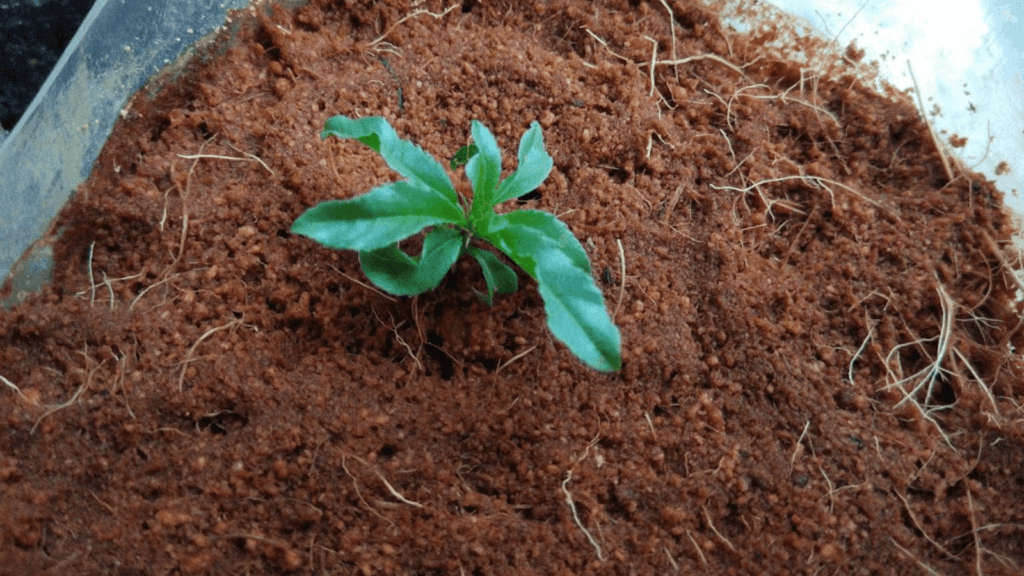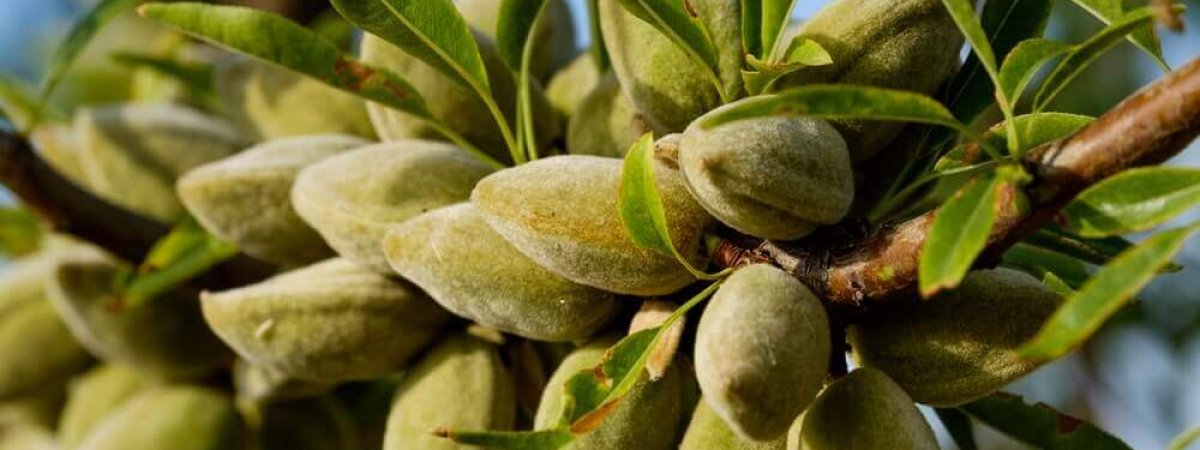Almond is a drupe or stone fruit with three layers – the exocarp (outer layer), mesocarp (fleshy middle layer), and endocarp (inner layer). An almond tree is of an average height of 6 meters or 20ft and fits in the Rosaceae family. The deciduous tree is considered as one of the oldest nut trees humans ever cultivated. The major areas of almond farming and cultivation include Central California, Texas, Arizona, Georgia, Italy, Spain, Morocco, Iran, Syria, and Australia.
Over the last few decades, the production of California Almond has increased by three times, making the country responsible for 80% of the world supply. In this blog, we have brought you everything you must know about how to grow an almond tree.
From planting to propagation, pruning and harvesting, we have discussed it all to add to your existing knowledge of the nut tree. Read on.

How to grow an almond tree?
Before we get started, let’s get into some important considerations for growing an almond tree, such as the soil and weather conditions suitable for the plantation.
Almond trees demand flat, deep fertile and loamy soil for proper growth and cultivation. You must also pay attention to the drainage system. The soil must not be too draining or heavy, And the pH value of soil must range to 5.5 to 8.5 for better cultivation
Coming to the weather conditions, a temperature range of 7°C to 24°C is suitable. The plant requires an average rainfall of 75 to 110 cm and an altitude of 750 to 3200 meters is also to start on a good note.

Steps to growing an almond tree
- You can start planting your almond tree in the field/garden before blossoming, during the winter season.
- Start with labeling areas in the field where you want to grow the trees. They are grown in hexagonal or rectangular patterns.
- Keep a minimum distance of 18ft between the young trees, mainly if your soil is enough fertile for cultivation.
- Once you choose the distance and mark the positions, dig and have the holes open. The dimensions of the holes should be 1.5 X 1.5ft with a depth of around 2ft.
- The young seedlings are planted at the same depth as in the nursery.
- Add a sufficient amount of surface soil to the root base of the seedlings. While adding the soil mixture, tap the root gently until the hole fills to protect the sensitive and young root from damage.
- Water the seedlings to keep the area moist. Do not soak it in water.
- Now add some manure around the seedling base to maintain proper soil moisture and prevent the seeds from weeding (This is an optional yet significant step).

Some significant things to know while growing almonds
- Typical distances or patterns of growing almond trees in your backyard are 18X18 ft, 20X20 ft, and 23X23 ft.
- When you plant the young almond trees at distances less than 18 feet, it will lead to overcrowding and mutual shadowing that will further result in decreased quality and quantity of production. Moreover, pruning and harvesting also get difficult.
- A standard 20 X 20ft distance results in 270 trees each hectare, or 109 trees each acre. The confined 18 X 18ft distance results in 330 trees each hectare, or 134 trees each acre.
- The professional almond growers who cultivate the nuts for commercial purposes plant one row of pollinating trees for every three main variety rows. This is to ensure proper cross-pollination, a necessary process for the germination of fruits.
- Proper plantation of almond trees helps in the harvesting process and sorting the varieties.
- Almond growers from several countries use a unique weed-preventing mat to cover the base of the young seedling and place a white cover to avoid sunburn.
- When growing almond trees from seed during winters, it is essential to irrigate the fields every 20-30days. However, during the summer season, the seedlings or young trees should have proper irrigation at a frequent interval of ten days.
- During the summer season, adequate water supply to the fruit-bearing plants is necessary because it prevents the unripe fruits from falling. You should also use leaves straws, and various organic materials on the soil around the planted seedlings to reduce weeds.
How to grow an almond tree from seed?
Though many aspiring gardeners look for ways to grow an almond tree from seed, it is not a 100% effective process as only 50% or fewer seeds germinate, as in case of fruit trees like apple, citrus, nuts, etc. The ideal way to harvest almonds is by planting two different fruit-bearing varieties in the same yard for the pollen to travel from one to another through honeybees.
Anyways, we don’t want to leave you disappointed. Here’s how you can grow an almond tree from seed:
- Start from searching for natural and freshly harvested almonds. They must be unheated, unroasted, unsalted, and untreated seeds, or else they won’t sprout.
- Once you have fresh seeds, select the best 10. Only some of these will succeed to become a small seedling and grow into a young tree.
- Soak the shelled almonds for 2-3 days and then break the shell to get the seeds inside.
- Place them on a wet towel and keep it in a plastic bag.
- Now place the bag in a refrigerator for around 3-4 weeks.
- After 3 weeks, you will find some seeds sprouting normally.
- Plant these in separate pots in room temperature.
- You can prepare a soil mix with compost and river sand. Plant the seeds only 1-2 inches below the soil.
- Make sure the seedlings are exposed to proper sunlight throughout the day. It’s better to place it by the window or on the balcony.
- Remember to keep the pots moist – not soggy.
- Once the seedlings grow to a height of 15cm (or 6 inches), you can transplant them to a bigger area or container.

Propagation
By root graft
Almonds, like several other nuts and fruit trees, are propagated through the process of budding. By far, it is the most efficient and easiest way to grow them just like the parent plant. A hard rootstock of bitter almond or peach can be used to provide the tree with the required resistance against soil-borne diseases. Now, the fruit-bearing branch goes through the process of grafting on to the rootstock.
When you use grafted almonds for planting a new tree, it offers more resilience and grows faster than from a seed. Another thing to keep in mind is that you need to plant two different yet compatible varieties of almond trees to allow them to cross-pollinate well, generally via bees.
Using the nut
You can always plan to grow your almond nuts from seed in the backyard, but also remember that it is a longer fruit-bearing process. However, the quality of the nut yielded may not be the same as the parent plants.
For propagating almonds from nuts, you need to get fresh nuts (not the roasted ones from the supermarket). Keep them aside soaked in water for 48 hours. Place them on a wet paper towel in a plastic bag and store it in the refrigerator.
Let it be there for around 3-4 weeks after which you will see some of the nuts sprouting. You should now take them out and prepare them to plant in a pot. Make a well-drained, fertile soil mix (mix of compost and sand). Place it in direct sunlight to ensure it’s warm and well ventilated.
Remember to keep the nuts moist, but not soggy. When they grow to a height of 6 inches, transplant it to the garden or a bigger container.

Pruning
Pruning is an important process that determines the shape and quality of the nuts an almond tree produces. It is carried out for different purposes at different phases of a tree’s life. A right pruning technique allows for easy harvesting of almonds.
Usually, almonds are pruned into a ‘vase’ type shape having 3 to 4 branches. When done correctly, the vase shape results in a more productive and vigorous tree with a longer life expectancy. On pruning a tree post maturity, it helps in maintaining its shape that is established during the early stages of growth. The process helps in renewing the tree and boosts it to bear more fruit (nuts). Around 20% of the canopy of an old tree should be pruned every year.
Harvesting
Harvesting almonds is a fun process. How? All you need to do is shake the tree hard to see the wrapped nut in the shells fall to the ground. You can place a sheet on the ground and then give the tree a hard shake, so it becomes easier to collect the almonds afterwards.
How will you know the nuts are ripe to pick? Notice the growth and as the hulls are seen splitting open, consider it the time of shaking off the fresh nuts. Normally, it’s late summer in the US. It would be great if you can leave them though three quarters from the time of the first split, it would be the safest time to harvest.
Before harvesting, you must make sure the nuts are dried. You can do this either by leaving them for a few days on the ground or preserving them in a cool and dry place. If you choose the former option, ensure there’s no risk of rain during that period.
A mature and healthy almond tree can yield almost 23-30 kilograms (50-65 pounds) of nuts.
Few significant things before you start growing almonds
Almonds are a nutritious nut with plenty of health benefits such as lowers cholesterol levels, boosts energy, reduces the risk of cardiac arrest, improves fertility problems.
Only sweet almonds can be used in cooking or consumed plain, while bitter almonds when consumed can be a life risk for humans as it contains a substance, amygdalin, that can be converted into a poisonous element.
In a Nutshell
If you have got a large backyard or garden, this guide on how to grow an almond tree can be a great help for your next gardening project. You can also grow almonds for commercial purposes. However, patience is the key to bear the delicious nut.
Image Resource: Google
You may also like to read
How to Grow Cardamom? – Everything From Propagation to Harvest and Storage






